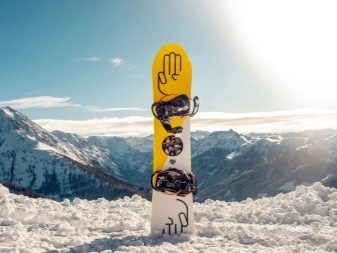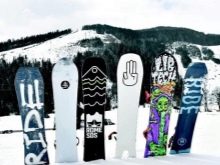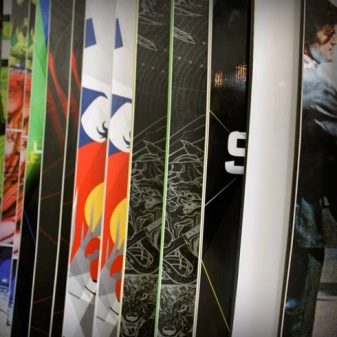All about snowboards

Knowing everything about snowboards, how to choose a board, and what it is, in general, means significantly expanding your sports capabilities. The selection of wall mounts and bumpers should be no less careful than the selection of female and other models for freestyle and other sports. Attention should also be paid to the repair of such equipment.


What it is?
Literally translated, the term snowboard means "snow board"; it would be more intelligent to translate it as "snowboard". This description exhaustively tells how such a sports equipment looks like. Downhill from snow-covered hills is the snowboarder's main occupation. Unlike a skier, this athlete does not ride on flat surfaces. A typical snowboard consists of:
- parts sliding on snow;
- bases (usually called a deck);
- edging, for the execution of which metal is used (the role of edging is the coordination of the movement of the snowboard using a special set of techniques).

But the role of such an item is not limited to simple sports. It literally became a breakthrough in winter outdoor activities. The skier, rigidly tied to the lifts, began to look much less extreme compared to the snowboarder walking everywhere on foot and skating calmly even off pistes. Advanced extremals often ride on the "snow board". However, everyone can buy it, and it is not difficult to learn how to use it.
It will take relatively little time and contact an experienced instructor. Snowboarding can be a lot of fun. The construction is divided into several layers.
The descent speed is determined not only by the craftsmanship, but also by the materials used.



History
Snowboard is a relatively young sports equipment. Its early prototype, the snerfer, was first designed by Sherman Poppen in 1965. Actually, the snerfer was just glued skis. Already in 1966, it became so popular that it was possible to start production. More and more snarers were being ridden, this type of equipment has been steadily improved by various manufacturers.
It is believed that the first snowboards in the modern sense appeared in the early 1970s. Their industrial production was started by Winterstick in 1972. In 1976, a pair of British skateboarders proposed their own design, which is much shorter than the snowboards we are used to today. The rapid development of this projectile (and the sports that use it) continued after that. So, already in 1983, the first half-pipe world championship was held. The World Cup among snowboarders is held in 1985, and before that, in 1984, an international association was established.


However, early snowboard designs were poorly handled. Their use was complicated by the high risk of accidents. Only a small fraction of the resorts allowed the use of such shells. Only the improvement of the products themselves and the development of effective driving techniques by the athletes made it possible to solve this problem. By the 1990s, almost all of the major ski resorts began offering detached snowboard slopes.
In 1998, snowboarders first entered the Winter Olympics. However, the quantitative increase in their number reversed slightly in the mid-2000s due to little snowy winter weather and an increase in interest in classic skiing.
True, snowboard still retains millions of loyal fans. His models are becoming more and more diverse, and this point should be given special attention.


Views
Geometry
There are several types of snowboards in terms of geometry. Twin-tip, or Twin-tip, is found among the shells for any style of travel. However, they are mainly used for freestyle. These boards are symmetrical, with the nose and tail having the same shape. On such equipment, you can calmly and skillfully perform any tricks, change surfaces and direction of movement.
Overseas snowboards are referred to as Directional. This asymmetrical product is ideal for freeriding. You can only move in one direction. The nose and tail of the board can have different mechanical properties. At the bow, the snowboard is bent especially strongly, which prevents it from getting stuck in soft snow.

There are also twin-directional designs, they are also Directional twin. It is believed that this is a fully-fledged universal option. Geometrically, along the contour, it repeats the classic twin-type. However, the mounts are shifted in relation to the middle. The stiffness of the ends may vary; As a result, the snowboard does not bury itself in the snow, and it controls the speed optimally.
Other important parameters are:
- growth group;
- width;
- side profile radii (but they are mostly interesting for professional athletes, not for beginners).


By appointment
Freeride, or All-Mountain, is especially popular. Almost all athletes will be satisfied with such a snowboard. You can ride it both at regular winter resorts and outside the well-equipped trails. Such equipment is readily purchased by beginners who are unlikely to enjoy a long tedious selection. Freestyle models are used by more experienced athletes.
This type of snowboard is suitable for riding in parks and on trampolines. They are generally shorter than the others, which allows for easier management. Importantly, freestyle is not suitable for fast downhill slopes.
The carving board is long, narrow and has increased rigidity. It is used mainly by high-level professionals who know exactly how to act.

Dimensions (edit)
The overall size of the snowboards directly affects their maneuverability. With the right length, riders can easily coordinate their movements. Without this condition, it is impossible to provide complex, beautiful maneuvers on the slope. The pace of the descent also depends on the length. A very long snowboard means excessive energy consumption.
Sticking to it is already a kind of art. The mini-snowboard sometimes fails and gets stuck in a rut. These traps can lead to falls and sometimes even injury. Most often, snowboarders choose their main tool individually, although there are recommendations with the selection for the height and body weight of the athlete. Snowboards up to 25 cm are considered narrow, and with a width of 25-26 cm, they belong to the average and standard groups.


Other characteristics
Deflection
The classic deflection is Camber. It is also known as positive deflection. This solution allows for excellent maneuverability and downhill speed. The "classic" is especially good on a compacted or thoroughly run-in surface by athletes. Such shells are also recommended for those skating in the jibbing technique.
Rocker Deflection or Reverse Deflection or Reverse Deflection is an innovative solution. Its demand has only increased in recent years. This type of snowboard has an “inverted board” effect. For inexperienced riders, they may be better suited than the classic model. If advanced athletes become Rocker, they can still achieve outstanding results.


Sidecut radius
The radius of an imaginary circle is known by this name. It should be adopted in such a way that it is along its contour that the side of the snowboard is successfully cut. The slit should go strictly from toe to tail along the entire length.
With a small radius, it will be possible to safely enter sharp turns - the stock of maneuverability is definitely enough. With an increase in this radius, it is easier to ride at speed, but you will have to turn around over a significant amount of space.


Rigidity
Taking a hard shell for novice athletes does not make much sense. On a soft snowboard, you can learn to stand and balance. Having gained some experience, it is worth switching to boards of medium hardness. Longitudinal stiffness affects primarily the behavior of the structure during acceleration. Torsional stiffness is used to assess grip on ice and strong snow.


Top manufacturers
- BF snowboards stand out among the companies producing universal snowboards. This is a very decent Chinese brand that boasts a relatively affordable price tag. From the point of view of technological excellence, there are no complaints about it. Such products are suitable for beginners who would like to get a reliable all-round shell without spending a lot of money.

- Arbor brand products are popular among young snowboarders. The products of this brand are distinguished by their original design. Arbor has been on the market since 1995 and initially focused on abandoning the standard appearance. The entire line of the company is suitable for complex technical details.
Beautiful, catchy names of models are also worth adding.

- Burton also deservedly appears in the rating of the best. This company was at the origin of snowboarding equipment. It has been successfully operating since 1977. Even Olympic and world champions who do not seek to acquire other most expensive models ride on equipment of this brand. Burton also supplies excellent snowboarding clothing and accessories.

- The Nidecker brand is good for freeriding. It has been on the market since 1984. The line of the company includes children's boards and non-standard models. The technological and innovative level is very high. An optimized manufacturing process ensures high quality at relatively affordable prices.

- Flow has entered the top over the past 20 years. In 2000, no one knew about her, and in 2014, many snowboarders rode her equipment in Sochi.Flow creates and modernizes many new systems every year. This company produces lightweight and reliable products. The official description emphasizes its reliability and stability.

- Products of the Nitro brand are appreciated for their reliability. This firm strives to use strictly first-class materials, despite their price. The cost of the finished product turns out to be quite high. But she will be able to serve at least 4 seasons. The same brand produces boots and bindings for them.

- Joint Snowboards work well for high speed skiing. This company was founded by professional athletes in Siberia. Its products are in demand at major competitions and championships. The location of production in Russia can significantly reduce the cost. In this plant, products are coated with a double layer of UV varnish; some of the production is done in Taiwan.

- Lib Tech products are distinguished for the quality of snowboards. The headquarters of this brand is located in the vicinity of Seattle. Experts have repeatedly recognized her products as the best choice for professional competitions. The company adheres to the original design and assembles its products by hand. The company has been operating since 1977.

Components
Boards are distinguished by their driving properties and the degree of reliability. The type of bindings for inexperienced and hobbyists - the Illusion 400 or Serenity 100 is best. If the snowboard is intended for freestyle, it should be equipped with a well-cushioned Illusion 700 clip. Also useful for snowboarding equipment:
- protective bumper (usually made of colored plastic);
- front edging;
- back edge;
- buckley;
- wall mounting;
- covers.


How to choose the right one?
Some parameters and basic rules for the selection of a snowboard have already been announced above. However, it is hardly worth limiting ourselves to them. First you need to decide on the level of your own skills. The easiest way is to follow the instructions of the manufacturers who classify their products according to the category of users. Beginners are considered those who have not yet skated at all or are only able to move slowly along a well-equipped track. In order to select the equipment, you need to pay attention to the desired riding style. Freestylers need relatively short soft boards. For freeride lovers, a classic deflection board or directional product is better suited.
The powder style, typical of professional athletes, implies increased stiffness and increased length. Equipment for this purpose usually has a mixed deflection, floats well in the snow and has improved handling. The correct choice of women's sports equipment cannot be reduced only to the preference for the model that weighs less. Design moments are important, but besides them, there are also nuances. The boot should protrude no more than 1 cm beyond the edge on either side.
The smaller the user's height, the shorter the optimal snowboard length (all other things being equal). When riding All Mountain, a product of medium length and medium rigidity will be optimal.



Nuances of repair and maintenance
Delamination of the board and associated scratching is often a problem. They arise from natural wear and tear of equipment and from collisions on hard surfaces. If you notice a scratch, you need to remove the burrs at its edges. Then the surface is cleaned of fat using acetone or alcohol (if there is no special branded liquid). It is necessary to repair the sliding surface with a special repair candle.
The delamination is removed by removing the delaminated material. Work should be done carefully, without touching any other part of the surface or creating scratches. Then with a knife along the perimeter of the exfoliated area, they scratch the lid. Then they put the first clamp, prepare glue and degrease the problem area. Having pushed glue into the core, apply a film on top, press it with a piece of wood and fix the entire assembly with a clamp; in a day everything will return to normal, and it will be possible to glue the knocked down part of the lid.

If the damage is more serious, you will have to contact a professional. Routine preparation for the season involves first and foremost the careful storage of the snowboard. It must be cleaned and dried, placed in a special case. Depending on the results of the inspection:
- sharpen edges;
- clean surfaces;
- cover with paraffin slip.










